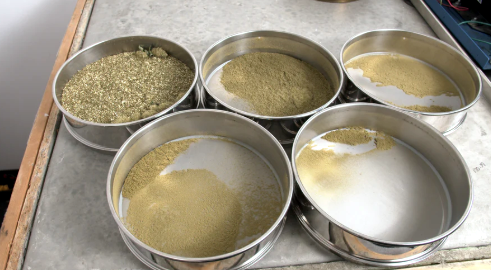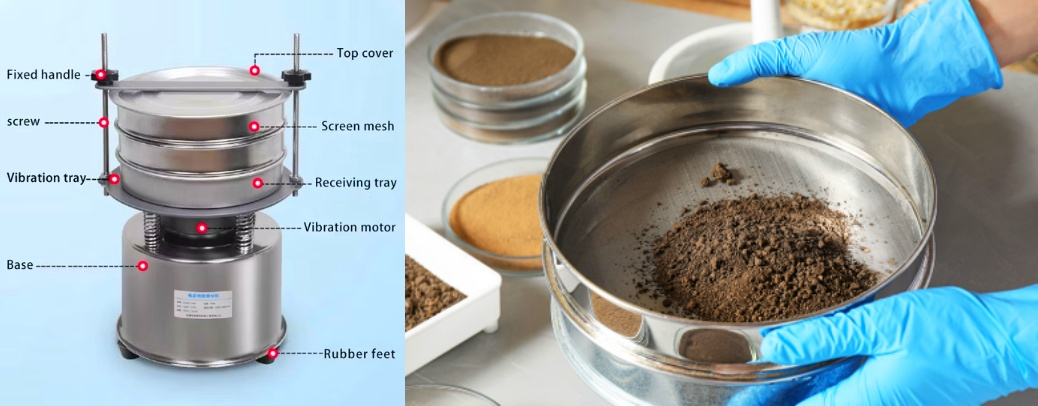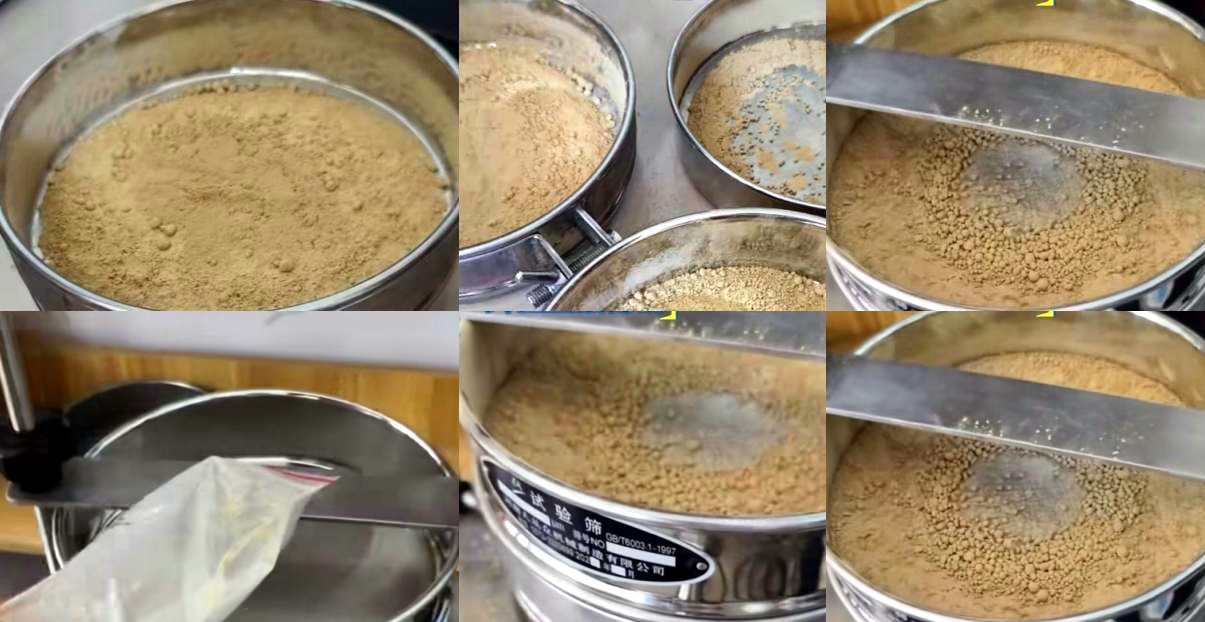Tuesday June-10 2025 16:32:04
Herbal powder lab sieve is a small experimental equipment for particle size analysis and screening of herbal powder, which is suitable for herbal research and development, quality inspection and preparation pretreatment. Because herbal powder has the characteristics of uneven particle size distribution, easy moisture absorption and agglomeration, and high viscosity in some parts, the lab sieve usually uses slapping vibration, rotation or electromagnetic method to drive the sieve to move, so that the powder is screened step by step on the multi-layer sieve.

The commonly used sieve mesh ranges from 20 to 200 mesh, among which coarse powder usually uses sieves below 40 mesh, fine powder and ultrafine powder mostly use 80 to 200 mesh, and some special preparations can reach more than 300 mesh. By reasonably configuring the sieve combination, not only can the powder particle size distribution be evaluated, but also coarse particles or impurities can be removed, and the consistency and quality control level of herbal powder can be improved.

The primary purpose of the herbal powder lab sieve is to achieve particle size classification. Due to the significant differences in the texture and composition of different herbals, such as the hard texture of mineral medicines, the particles are larger after crushing; the medicines containing fiber and sticky components are easy to agglomerate, and the powder particle size is uneven. Through the sieves of different mesh numbers of the lab sieve, the herbal powder can be separated into different grades of coarseness and fineness to ensure that the powder particle size meets the requirements of the preparation. For example, when preparing powders, sieving out fine powders above 100 mesh can avoid the granular feeling when taking; when making pills, the powder of appropriate particle size is conducive to molding and disintegration.

In addition, the lab sieve is also used for impurity separation and quality control. During the harvesting and processing of herbal, non-medicinal parts, sand and gravel and other impurities are easily mixed in. These foreign objects can be removed by screening. The standardized screening process is a key link in the quality control of herbal. Through the unified mesh detection, the particle size of different batches of herbal powder can be guaranteed to be uniform and the efficacy can be maintained.
Although the herbal powder lab sieve plays a fundamental and irreplaceable role in the quality control of herbal, it has limitations in handling sticky and ultrafine powders and providing comprehensive particle size information.

① Limitations on sticky powders: Many Chinese medicinal materials contain sugars, colloids, resins and other ingredients, which are easy to absorb moisture after crushing, resulting in strong stickiness of the powder. These sticky powders are easy to adhere to the sieve holes during the screening process, causing the sieve holes to be blocked, affecting the screening efficiency and accuracy.
② Accuracy limitation: Although the lab sieve can provide a certain degree of particle size classification, for very fine particles (such as powders with a mesh size of more than 300), traditional screening technology may be difficult to achieve the ideal separation effect, resulting in inaccurate particle size distribution.
③ Unable to provide comprehensive particle size distribution information: The lab sieve can only divide the powder into several particle size intervals and cannot provide a continuous and fine particle size distribution curve. For research that requires more accurate particle size distribution data, other particle size analysis instruments, such as sedimentation instruments, are required.

|
Sieve number |
Mesh number (mesh) |
Sieve hole inner diameter (μm) |
Application examples |
|
No. 1 sieve |
10 mesh |
2000±70 |
Separation of coarse particles (such as initial screening of mineral medicinal materials) |
|
No. 2 sieve |
24 mesh |
850±29 |
Screening of coarse powder (such as initial classification of rhizome medicinal materials after crushing) |
|
No. 3 sieve |
50 mesh |
355±13 |
Screening of medium powder (applicable to some pills and powder raw materials) |
|
No. 4 sieve |
65 mesh |
250±9 |
Screening of fine powder (such as general tablets and capsule raw materials) |
|
No. 5 sieve |
80 mesh |
180±7 |
Screening of fine powder (for powders and granules with higher requirements) |
|
No. 6 sieve |
100 mesh |
150±6 |
Screening of the finest powder (such as ophthalmic preparations, external powders) |
|
No. 7 sieve |
120 Mesh |
125±5 |
Extra-fine powder screening (such as respiratory inhalation, cavity medication) |
|
No. 8 sieve |
150 mesh |
90±4 |
Extra-fine powder screening (for fine classification after ultrafine grinding) |
|
No. 9 sieve |
200 mesh |
75±2.9 |
Ultra-fine powder screening (such as nano-grade herbal powder or special preparations) |
In the field of herbal powder screening, different types of lab sieves have their own applicable scenarios according to the properties of powders and testing needs. The slapping sieve is often used for particle size detection after herbal pieces are powdered. It is suitable for screening coarse and medium powders between 20 mesh and 100 mesh.

It is widely used in the quality inspection department of pharmaceutical factories to determine whether it meets the fineness standards specified in the pharmacopoeia. The ultrasonic lab sieve is suitable for screening ultra-fine powders with a fineness of more than 200 mesh. It can effectively prevent fine powder from blocking the net and agglomerating.
It is often used in herbal research institutions and preparation development units, and has high requirements for powder uniformity and active ingredient distribution. The electromagnetic lab sieve is suitable for herbal powder with good looseness and wide particle size distribution due to its high-frequency micro-vibration mode. For example, it is used to detect the particle size distribution of a mixture of various herbal powders. It is commonly used in the research and development stage or university laboratories.
When choosing a herbal powder lab sieve, the purpose of screening should be clarified first, whether it is coarse and fine classification or accurate particle size distribution analysis. The physical properties of herbal powder, such as viscosity, humidity and fragility, will directly affect the screening effect and the selection of the screen. For example, for powders with high viscosity, a sieve machine with a special vibration mode or auxiliary cleaning device should be selected to prevent clogging.

The mesh number of the sieve should be selected according to the pharmacopoeia standards or product process requirements to ensure that the sieved particle size meets the regulations. According to the size of the sample processing volume, select a lab sieve equipment of appropriate size and processing capacity. If the accuracy of particle size analysis is required to be high, high-precision sieves and stable screening equipment should be used first.
The selection of sieve number can refer to the pharmacopoeia and preparation type. For example, decoctions often use coarse powder, corresponding to No. 13 sieve; pills mostly use fine powder, and No. 68 sieve is often used. If you encounter the problem of low screening efficiency, you can consider using a vibrating screen or an ultrasonic screen, and equip it with a net cleaning device to reduce net blockage and improve efficiency. To ensure the accuracy of the screening results, the operation should be strictly in accordance with the pharmacopoeia regulations, control the sample amount (generally 50~100 grams), and ensure sufficient screening time.

The herbal powder lab sieve is mainly used for particle size analysis and screening of herbal powder to ensure that the herbal powder meets the specific particle size requirements. It is usually composed of sieves of different mesh sizes, which are arranged according to the aperture size, and powders of different particle size ranges can be separated. For herbal powder, the commonly used sieve mesh range depends on the required powder fineness. Choosing a suitable lab sieve and the correct operation method are crucial to ensuring the quality of herbal. In addition, the lab sieve needs to be cleaned and maintained regularly to ensure its accuracy and reliability.
Herbal Powder Lab Sieve Shaker
The herbal powder lab sieve shaker is a laboratory equipment specially used for screening, impurity removal and particle size classification of traditional Chinese medicine powder. ...
What is the wet sieving process?
Wet sieving process is a sieving process assisted by a liquid (usually water or a solution containing a dispersant) to more effectively...
Fines content tester can be defined as an instrument used to quantitatively determine the content of fines powder components of a specific fineness...
Micro silica powder particle size analysis test sieve
Micro silica powder, also known as silica fume, is an ultrafine active silica material with a very small particle size, usually between 0.1-0.3 microns, which...
Agricultural gruesos Test sieves
Agricultural gruesos test sieves are experimental equipment used for particle size analysis, grading and testing of agricultural soil, gruesos...
Stainless steel frame and woven cloth
The test sieve is a laboratory equipment used for particle size analysis. Its core components usually include a stainless steel frame and woven cloth (also called a sieve)...
Fine aggregate test sieve is a special instrument for determining the particle gradation of fine aggregates such as sand and stone chips with...
Jun 10, 2025
The main purpose of the herbal powder lab sieve is to achieve particle size classification and impuri...
Jun 07, 2025
Fine aggregate test sieve is a special tool for analyzing the particle gradation of fine aggregate (s...
Jun 06, 2025
Soil sieving analysis is done by dry or wet sieving, using a series of standard sieves to separate so...
Jun 05, 2025
ASTM standard soil analysis sieves with pan and cover
The main function of the ASTM standard soil analysis sieve (with pan and cover) is to accurately sepa...
![]()
Then we look forward to hearing from you
Contact Us
Industrials
Yanjin county forest park gate to the west 1000 meters north road sitemap
